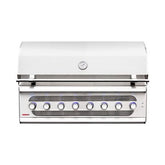Energy Efficiency Tips for Maximizing Your Performance Of Manufactured Wood Stoves in USA
A wood stove is more than just a heating solution; it’s a cozy centerpiece for your home. However, to get the most out of your wood stove, it’s crucial to use it efficiently. By optimizing your wood stove’s performance, you can enjoy a warm home, lower heating bills, and reduce your environmental footprint. Here we have covered some top ways and practical energy efficiency tips to help you maximize your performance of manufactured wood stoves in USA.

Top Ways To Increase Your Wood Stoves Shelf Life
Undoubtedly wood stoves are one of the wisest decisions one can make since they deliver a natural and cost-effective source of heat. Its longevity is determined by many elements, including the product's quality, how it is used, and how well it is cared for.
However, it is crucial to note that a wood stove's life duration might be reduced if it is abused or badly maintained.
But if one follows the manufacturer’s tips then there’s no way one can stop you from using your favorite wood stove for the next 10 - 15 years. Wondering how? Let’s go through this blog together to understand the efficient ways of using wood stoves in USA.
- Choose the Right Wood
Selecting the right type of wood is fundamental. Woods like oak and maple usually burns hotter and longer as compared to softwoods. Make sure your wood is seasoned, meaning it has been dried for at least six months. Well-seasoned wood has a moisture content of less than 20%, which ensures a cleaner, hotter burn and reduces creosote buildup in your chimney.
Also, note here that when selecting a wood stove, look for one that is EPA-certified. These stoves are designed to burn wood more completely, reducing emissions and increasing heat output. Additionally, consider the size of the stove. A stove that is too large for your space will waste fuel, while one that is too small won’t provide enough heat.
- Use a Moisture Meter
Investing in a good moisture meter will help you sustain your wood stove life. This handy tool measures the moisture content in your logs, ensuring they are dry enough for efficient burning. Wood with high moisture content wastes energy as it burns off excess water, leading to lower heat output and more smoke.
3. Maintain Your Wood Stove Regularly
Regular maintenance is key to efficient operation. Clean the ash pan regularly to prevent ash buildup, which can obstruct airflow. Additionally, schedule an annual chimney inspection and cleaning to remove creosote deposits, which can reduce efficiency and pose a fire hazard.
- Don’t Skip Optimizing Airflow
Efficient combustion requires proper airflow. Always ensure that your wood stove's air vents are clean and unobstructed. When starting a fire, keep the vents fully open to get the fire going quickly. Once you lit the fire don’t forget to adjust the vents to control the burn rate and maintain a consistent temperature. It will help you regulate your buck stove in a better way and will maximize its life.
- Fireback Will Be A Saviour
A fireback is a metal plate placed behind the fire in your wood stove. It reflects heat into the room, increasing the stove's efficiency. Firebacks can also protect the stove’s back wall from damage, extending its lifespan so if you consider opting for this while looking for Wood stoves for sale know that you’re going to multiply your wood stove’s life.
6. Install a Heat-Powered Stove Fan
A heat-powered stove fan can significantly improve heat distribution. These fans sit on top of the stove and circulate warm air throughout the room without using electricity. This simple addition can make a noticeable difference in how evenly your home is heated.
- Practice Efficient Burning Techniques
Stack your wood in a crisscross pattern to allow air to circulate the logs. This promotes a more complete combustion process, producing more heat and less smoke. Avoid overloading the stove with too much wood at once; smaller, frequent loads burn more efficiently.
- Insulate Your Home
A well-insulated home retains heat better, allowing your wood stove to work more efficiently. Seal any drafts around windows and doors, and consider adding insulation to your attic and walls. The better your home retains heat, the less hard your wood stove has to work.
- Use a Stove Thermometer
A stove thermometer helps you monitor the temperature of your stove. Keeping the stove within the optimal temperature range ensures efficient burning and prevents overheating, which can damage the stove and waste fuel. The ideal temperature range for most wood stoves is between 300°F and 500°F.
- Upgrade to a High-Efficiency Wood Stove
If your wood stove is old, consider upgrading to a modern, high-efficiency model. Newer stoves are designed to burn wood more completely, producing more heat with less fuel. They also emit fewer pollutants, making them a greener choice for your home.
Bring your Home The Top-Notch Wood Stove!
Maximizing your wood stove's energy efficiency not only saves you money, but it also makes your home warmer and more comfortable. By following these guidelines—choosing the right stove, utilizing seasoned wood, maintaining optimum airflow, and keeping your stove clean—you can get the full benefits of your wood stove while lowering your environmental impact. Invest in excellent equipment and perform regular maintenance to keep your cooker functioning well for years to come.
Are you ready to increase your heating experience? Explore North Woods Grills,
selection of high-efficiency wood stoves, Gas logs for fireplaces, and a lot more today and make your home a cozy, energy-efficient retreat.










